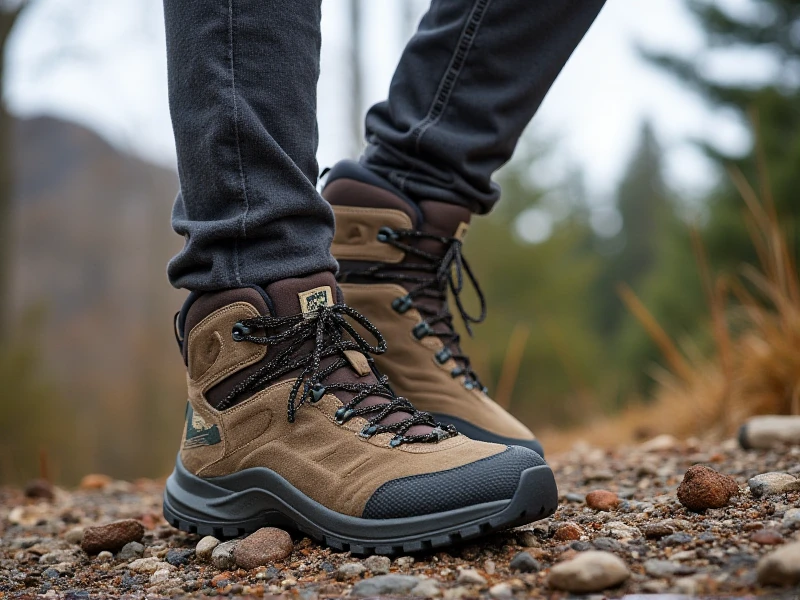Ultimate Guide to Men's Hiking Shoes: Finding Your Perfect Trail Companion
2025-06-03

Hitting the trails offers unmatched freedom, fresh air, and stunning views. But any seasoned hiker knows: your adventure lives or dies by your footwear. Choosing the right men's hiking shoes isn't just about style; it's about comfort, safety, performance, and unlocking miles of enjoyable exploration. Let's break down what makes men's hiking shoes essential and how to find your ideal pair.
Why Specialized Men's Hiking Shoes?
Why not just wear your gym sneakers? Standard athletic shoes lack the critical features demanded by variable, often rugged terrain. Men's hiking shoes are engineered specifically for the outdoors:
1. Enhanced Protection: Reinforced toes (often with rubber bumpers) shield feet from rocks and roots. Durable uppers provide abrasion resistance.
2. Exceptional Traction: Aggressive, lugged outsoles grip onto mud, loose scree, wet rock, and slippery surfaces far better than any street shoe sole. Vibram® or proprietary rubber compounds offer reliable stickiness.
3. Superior Support & Stability: Built-in ankle support and torsional rigidity underfoot stabilize your stride on uneven paths, reducing fatigue and minimizing roll-overs.
4. Weather Preparedness: Options range from highly breathable, quick-drying mesh for dry climates to fully waterproof (like Gore-Tex®) liners keeping feet dry in rain, snow, or stream crossings.
5. Long-Lasting Durability: Harsh trails demand rugged materials – tough synthetics, ripstop nylon, abrasion-resistant overlays – built to endure miles of punishment.
Key Features to Consider
Selecting the best men's hiking shoes involves understanding these crucial features:
Type:
Hiking Shoes (Low-Cut): Offer greater agility and breathability. Ideal for day hiking on well-maintained to moderately rough trails with lighter loads. Feel closer to a sneaker.
Hiking Boots (Mid to High-Cut): Provide maximum ankle support and protection. Essential for carrying heavier packs, navigating very rocky, steep, or technical terrain, or requiring serious waterproofing over longer distances.
Trail Runners: Ultra-lightweight, highly flexible, and breathable. Suitable for fast & light hiking or running on established trails. Less ankle support and protection.
Fit & Comfort:
Sizing: ALWAYS try hiking shoes on with the socks you plan to wear. Feet often swell during hiking. Generally, you need a thumbnail's width of space between your longest toe and the shoe's end, especially when going downhill.
Width: Brands offer varying widths. Ensure ample room across the ball of your foot without feeling loose. Heel slip is problematic.
Breaking In: Never start a major hike in brand-new shoes. Wear them extensively (indoors and short walks) beforehand to avoid blisters.
Materials & Construction:
Leather: Traditionally durable and naturally water-resistant (especially full-grain), but heavier and requires more breaking in. Nubuck/split-grain leathers are lighter but less water-resistant.
Synthetics: Fabrics like nylon and polyester are typically lighter, breathe better, dry faster, and require less break-in. Often combine durability with weight savings.
Waterproof Membranes: Membranes like Gore-Tex® or proprietary brands (e.g., eVent®) offer superb waterproofing and wind protection. Remember, they also reduce breathability, potentially causing warmer feet on hot days. Non-waterproof (fast-drying mesh) is ideal for desert or summer hiking.
Traction & Outsole:
Lug Depth & Pattern: Deep, multidirectional lugs provide better grip, especially in muddy or soft conditions. Firmer, more closely spaced lugs excel on rock. A pronounced heel brake assists on descents. Trusted rubber compounds (e.g., Vibram®) are standard for longevity and grip.
Support & Cushioning:
Midsole: EVA foam is common for cushioning; firmer plastic or TPU shanks provide essential torsional stability over rocks and roots. The stiffness needed depends on your pack weight and terrain difficulty.
Footbed/Insole: Many stock insoles are passable, but quality aftermarket insoles can drastically improve comfort, arch support, and biomechanics. Consider custom orthotics if necessary.
Matching Your Shoes to Your Adventures
Easy, Dry Trails / Day Hikes: Lightweight hiking shoes or trail runners.
Moderate Terrain / Wet Conditions: Hiking shoes or mid-cut boots with waterproofing (Gore-Tex®) and solid traction.
Rugged Terrain / Heavy Packs / Backpacking: Sturdy mid or high-cut boots offering ankle support, torsional rigidity, and durable construction, often waterproof.
Hot Weather / Fast & Light: Non-waterproof, breathable trail runners or low-cut hiking shoes.
Pro Tips for Longevity and Performance
Clean & Dry: Remove dirt/mud after hikes. Stuff with newspaper to absorb moisture. Never use direct high heat (like a radiator) to dry; it damages materials.
Waterproof Renewal: Apply manufacturer-recommended treatments (like Nikwax®) to leather or nubuck regularly to maintain water-repellency.
Rotate Pairs: If you hike frequently, rotating shoes allows materials to fully dry and recover, extending their lifespan.
Replace When Worn: Treads worn smooth or midsoles compressed mean compromised support, traction, and shock absorption – it's time for a new pair.
Invest in Your Journey
Don't let blisters, soggy feet, or unstable footing ruin your connection with nature. The right men's hiking shoes aren't just gear; they're trusty partners that ensure every stride is confident and comfortable. Take the time to assess your needs, try on multiple pairs diligently, and understand the features. When you lace up a shoe perfectly matched to the trail and your feet, you unlock the true freedom and joy of hiking. Happy trails!
(Approx. 810 words)
Category: